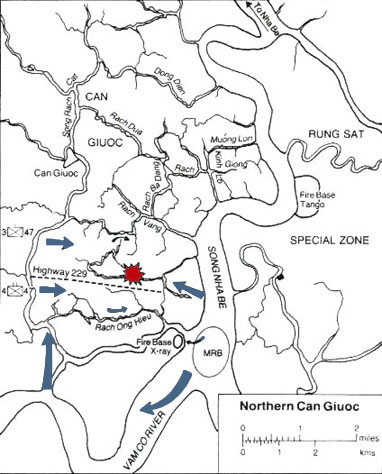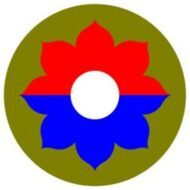A Day Remembered!

The Mobile Riverine Force sent five companies of the two U.S. infantry battalions into the operations area by assault craft. The sixth company, Company C, 3rd Battalion, 47th Infantry, moved by water to an air pickup zone to stand by as reserve. The troops entered the area and searched south, using assaultan craft to cross water barriers and to provide communications and fire support. The 2nd Battalion, 46th Infantry, Army of Viet Nam, moved through the darkness and established a blocking position near the town of Ap Bac, oriented to the east. At approximately 1000, Colonel Fulton was notified through the Mobile Intelligence Civil Affairs Team, located near Can Giuoc District headquarters, that the district chief had information of a Viet Cong battalion-size force due east of the blocking position of the 2nd Battalion, 46th Infantry. The brigade commander issued a fragmentary order at 1010 informing the commanders of the 3rd and 4th Battalions, 47th Infantry, and the U.S. advisor to the Viet Nam Army Battalion of the reported enemy strength and location. The order directed the two U.S. battalions to continue their maneuver south toward their newly designated objective – the reported location of the enemy battalion. Colonel Fulton also directed Colonel Tutwiler, commanding the 4th Battalion, 47th Infantry, to prepare to assume control of Company C, 3rd
Battalion, 47th Infantry, and to deploy the company by helicopter south of the reported enemy location. Colonel Tutwiler moved Company C at 1105 by air south of the reported enemy location with the mission of moving northeast to reconnoiter the enemy position.
By 1150 Company C of the 3rd Battalion had swept the reported enemy location without finding the Viet Cong. Company C of the 4th Battalion was moving west from its landing area when it was fired upon from the north. At the same time Company A of the 4th Battalion, moving south but at a distance of some 800 meters north of Company C, 4th Battalion, encountered heavy automatic weapons and small arms fire from its front and right flank. The enemy position turned out to be north of the reported location. Company A, lacking cover, suffered heavy casualties. The Viet Cong had occupied well-fortified firing positions in an L-shape along the north bank of the stream that separated Company A from both Company C of the 3rd Battalion and Company C of the 4th Battalion, 47th Infantry. Colonel Tutwiler shifted Company B of his battalion, which had been moving on the battalion’s right flank, into the area behind Company A to assist by fire and with medical evacuation. He held his Company C on the south side of the stream to maintain contact and maneuvered Company C, 3rd Battalion, north across the stream. Once on the north bank, Company C, 3rd Battalion, fought slowly to the east, with its right flank on the stream. Major H. Glenn Penny, executive officer and acting commander of the 3rd Battalion, 47th Infantry, meanwhile moved his Companies A and B southeast to link up with Company C of the 3rd Battalion on that company’s north flank. At 1545 Major Penny resumed operational control of his Company C. Company B attacked east on line with Company C while Company A moved into a blocking position 600 meters north of the left flank of Company B. By 2000 darkness and enemy fire prompted a halt to maneuver and placed Companies B and C, 3rd Battalion, some 600 meters west of Company C of the 4th Battalion where the units remained throughout the night of 19-20 June.
In the movement of the two U.S. battalions toward the first reported enemy location, the naval assault craft were limited to movement on the stream paralleling the 4th Battalion’s left flank. When Company C of the 4th Battalion was fired upon at 1150, the naval assault craft that had brought in the company provided fire support for it and, later, for Company C of the 3rd Battalion as it crossed the stream west of the actual enemy positions.
Although the rifle Companies and the naval assault craft quickly returned the enemy fire, artillery and helicopter gunship fire could not be immediately brought to bear because the heavy casualties initially suffered by Company A of the 4th Battalion prevented the company commander from determining the dispositions of his platoons. Artillery fire began at approximately 1200; it was delivered at the forward observers’ request and coordinated by ground and airborne artillery observers. Support was provided during the daylight hours and well into the night by helicopter gunships, medical evacuation helicopters, and assault craft.
The movement of Companies A, B, and C, 3rd Battalion, 47th Infantry, required the entire afternoon, but not all companies were able to link up before dark. The 2nd Battalion, 46th Infantry, Viet Nam Army, remained in its original position during the engagement because Colonel Fulton decided that maneuver of the battalion to the east would be complicated by the presence of U.S. companies between the Viet Nam battalion and the enemy.
Viet Cong and U.S. troops exchanged fire throughout the daylight hours and into the night. U.S. troops found that the enemy’s reinforced bunkers could be destroyed only by 90-mm. recoilless rifle fire and helicopter rockets and bombs; the 20-mm. and 80-mm. rounds fired by the assault craft penetrated a bunker only after multiple hits.
Casualties of Company C of the 3rd Battalion were evacuated during the afternoon and evening of the battle by plastic assault boat and helicopter. Company C of the 4th Battalion was unable to use the assault craft for medical evacuation and relied on helicopters. Whether casualties were taken directly by helicopter from a ground pickup zone or an armored troop carrier aid station after treatment, they were sent either to the barracks ship USS Colleton or to a field hospital. During the afternoon and evening of 19 June most of the enemy losses came from U.S. supporting fire concentrated on a small area. A portion of the enemy battalion eluded the U.S. blocking positions during the night, probably by crossing the stream west of Company C, 4th Battalion, 47th Infantry, and then moving south. On 20 June the 4th Battalion, 47th Infantry, searched south to make contact with the enemy. Moving by helicopter and on foot the battalion found the enemy north of the Rach Gion Ong stream at Ap Nam and, aided by a company of the 2nd Battalion, 60th Infantry, encircled and eliminated an enemy platoon.
